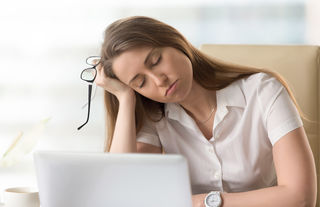Career
5 Simple Fixes for an Afternoon Slump at Work
What to do when your energy and focus take a nosedive after lunch.
Posted February 22, 2018

You know the feeling: It’s 2 p.m. at the office, and you have a ton of work to finish up before heading home. But the only thing you really feel like doing is curling up in a quiet corner and falling asleep. This afternoon drop in energy and focus can lead to careless mistakes and lost productivity at work. If your energy level is falling off a cliff every afternoon, here’s how to pick it up again.
Work with your body’s natural rhythms
The urge to sleep naturally waxes and wanes at certain times of day. According to the National Sleep Foundation, it’s generally strongest between 2 and 4 a.m., which is convenient for most people, and between 1 and 3 p.m., which is decidedly not.
To the extent that you can, schedule your work activities around your natural highs and lows in alertness. People typically experience a peak in alertness around 8 to 9 a.m., so that’s often an excellent time to tackle the most cognitively demanding and detail-oriented tasks. If you save such tasks for the early afternoon, be aware that you may not be operating at 100% efficiency.
Eat a good lunch, including some healthy fat
Avoid loading up on refined carbs and sugar. They can cause a sudden spike in blood sugar that gives you a quick pick-me-up, followed shortly by a crash that leaves you tired and hungry. To stay energized and feeling full for longer, build your lunch around high-quality protein combined with fiber-rich whole grains, vegetables, and fruits. Include some healthy, unsaturated fat.
In one study, overweight adults were randomly assigned to eat lunches containing either almonds or extra refined carbs (such as white bread) for three months. The meals contained the same number of calories, but the almond-enriched lunches provided more fiber and “good” fat. In both groups, memory test scores dropped about a half hour after eating. But the decline was lessened in the almond group, likely thanks to the mix of lower carbs, higher fiber, and healthy fat.
Pay attention to your calorie intake as well. Research has confirmed what anyone who ever supersized a meal already knew: Drowsiness is a bigger problem after a heavy meal than a light one.
Grab a nap, if you can—but keep it short
If you’re struggling to keep your eyes open, taking a nap seems like the obvious solution. Indeed, research has shown that a short nap can reduce drowsiness and may help combat an afternoon slump in certain cognitive abilities. For example, one study showed that nappers experienced less decline in cognitive flexibility—the ability to switch their thinking quickly from one thing to another—compared to those who didn’t nap.
The ideal length for a workplace nap is 20 minutes or less. Longer naps can cause sleep inertia—a sense of grogginess that may linger for several minutes after awakening. If your boss objects to snoozing on the clock, point out that a growing number of companies—such as Nike, Google, and Ben & Jerry’s—have already adopted nap-friendly policies.
Stand up and move around for a few minutes
Walk down the hall, up and down the stairs, or around the block. Do some jumping jacks or wall pushups. Use a jump rope or set of hand weights that you keep stashed in your desk. Run through a yoga or tai chi sequence. Doing something physically active is a great way to revive flagging energy and engagement.
If you can step outside and stroll among trees and flowers, your focus and mood may get an added lift. But even if you simply stroll among the cubicles, research shows that moving around may help you feel less bored and sluggish.
Wake up your brain with bright light
Exposure to bright light gives your sleepy brain a wake-up call. In one study, participants wore special glasses, which emitted either bright blue light or dim orange light, for 30 minutes after lunch. The results showed that the early-afternoon dip in cognitive flexibility was diminished in the group wearing bright-light glasses.
Typical office lighting is around 500 lux (a unit of illumination). The bright-light glasses used in the study were four times brighter (2,000 lux), and many light therapy boxes are 20 times brighter (10,000 lux). If you’re thinking about trying a bright-light device, ask your health care provider for guidance on how to safely maximize the benefits.
Of course, you could also simply pop outside to enjoy the sunshine on your break. The change of scenery, especially if it offers a glimpse of nature, may give your brain the extra boost it needs to power through the rest of your day.




